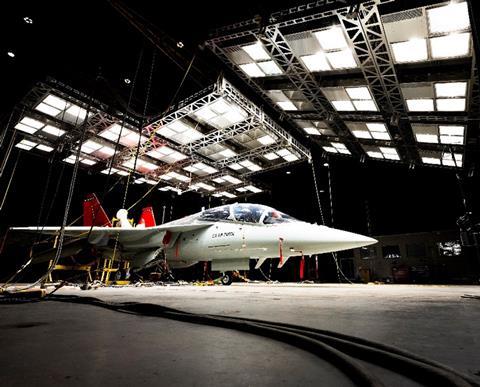Boeing has reached three milestones in the development of its delayed T-7A advanced jet trainer programme, including progress with the aircraft’s ejection seat and flight-control laws.
In February, Boeing and the US Air Force (USAF) undertook a dynamic sled test at Holloman AFB in New Mexico.

The test explored design changes with the Collins Aerospace ACES 5 ejection seat and the canopy fracturing system, with an aim to reduce the risk of injury to pilots.
“During the test, the team implemented variable timing to slow down the ejection seat using the drogue chute and investigated canopy fracturing system patterns,” says Boeing.
“The team is now preparing to move forward with the next round of development testing.”
The ACES 5 seat is designed to handle a broader range of pilot sizes than previous-generation ejection seats.
Issues with the T-7A’s ejection seat have resulted in delays and cost overruns for the programme, the successor to the USAF’s obsolescent Northrop T-38Cs.
February also saw Boeing complete development of a new T-7A flight-control law. Subsequently, 10 flights were conducted, with the aircraft reaching an angle of attack of 25°.
The work clears the way for high angle-of-attack and departure-resistance tests at Edwards AFB, California.
Additionally, an engineering and development example of the T-7A – test asset APT-3 – has undergone climatic tests at Eglin AFB in Florida. The tests saw the jet endure temperatures ranging from 43°C (110°F) to -31°C.
“This test evaluated the aircraft system’s performance, including propulsion, hydraulic, fuel, electrical, secondary power, environmental control, and overall operations in extreme environmental conditions,” says Boeing. “The aircraft has since returned to St. Louis for testing.”
In the first quarter of 2024, Boeing incurred a charge of $94 million related to the T-7A.
BOEING SECURES ADDITIONAL MH-139A CONTRACT
Boeing has secured a $178 million contract for seven MH-139A Grey Wolf helicopters, which are destined to replace the Bell UH-1H in securing US Air Force intercontinental ballistic missile silos.
The order brings the total number of MH-139As contracted to 26.
Based on the Leonardo Helicopters AW139, the first MH-139A was delivered to the US Air Force in March.


























